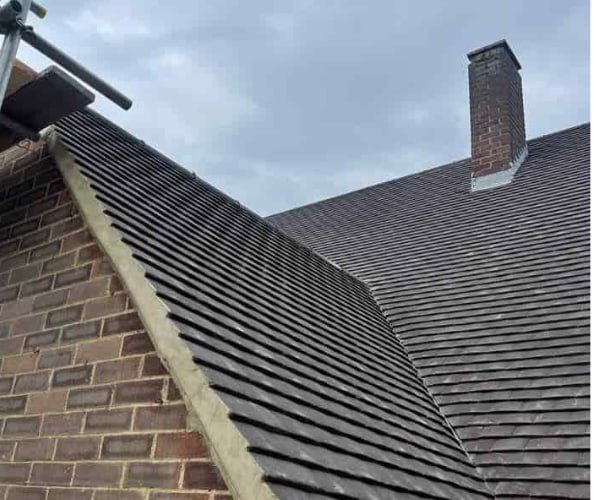What Causes Felt Roofing to Crack or Lift?
Introduction
Felt roofing remains one of the most popular choices for flat roofs across the UK — particularly for garages, sheds, extensions, and outbuildings. It’s widely used because of its affordability, versatility, and ease of installation. But like any roofing material, felt is not immune to wear and tear. Over time, homeowners in places like Brixworth may notice areas where the felt begins to crack, blister, or lift at the edges.
Understanding what causes these issues can help you prevent long-term damage and maintain the lifespan of your roof. At NGF Roofing Brixworth, we’ve seen the full range of issues affecting felt roofs across Northamptonshire. In this article, we’ll explore the key causes of cracking and lifting in felt roofing — and why timely intervention matters.
1. Ageing and Natural Weathering
No roofing material lasts forever. As felt roofing ages, the material begins to break down due to constant exposure to the elements.
What to expect with age:
- Loss of flexibility in the felt, making it brittle.
- Cracking due to shrinkage from UV exposure.
- Degradation of adhesive layers over time.
Older roofs are particularly susceptible during extreme temperature changes, where contraction and expansion cycles weaken the integrity of the felt.
2. Poor Installation Practices
Improper installation is one of the leading causes of premature failure in felt roofing. If corners are not sealed correctly or layers are not bonded properly, problems may begin to show in just a few years.
Common installation faults include:
- Inadequate heating of bitumen during application.
- Insufficient overlap between felt layers.
- Failure to correctly secure edges and joints.
At NGF Roofing Brixworth, we ensure every felt roof is laid using tried and tested methods, avoiding the shortcuts that often lead to early issues.
3. Water Pooling and Inadequate Drainage
Felt roofing systems must be installed with the correct slope to allow rainwater to run off efficiently. If water is allowed to pool, it puts constant pressure on the surface and accelerates wear.
Effects of standing water:
- Soaks into weak points, leading to rot or leaks.
- Increases weight on the roof deck, straining the structure.
- Traps moisture that causes the felt to lift or bubble.
Ensuring the roof has sufficient pitch and a clear drainage route is vital to maintaining its long-term performance.
4. UV Exposure and Sun Damage
Although the British climate isn’t known for intense sunshine, UV rays still have a major impact on roofing materials. Prolonged exposure can dry out the surface of felt, making it more prone to cracking.
UV-related deterioration includes:
- Fading and brittleness of the top layer.
- Loss of essential oils that keep the felt pliable.
- Surface splitting during hot summer spells.
Roof felt exposed to direct sunlight without a protective mineral finish will degrade faster, especially on south-facing structures.
5. Thermal Movement and Temperature Fluctuations
Flat roofs are particularly susceptible to thermal movement — the natural expansion and contraction caused by changes in temperature. If the felt doesn’t have room to move or isn’t flexible enough to cope, cracking or edge lifting can occur.
Signs of thermal stress:
- Cracks appearing at stress points or edges.
- Separation of felt layers near fixings or joints.
- Buckling or rippling across the surface.
Using high-quality felt with built-in reinforcement helps reduce these issues, especially in exposed locations around Brixworth.
6. Structural Movement or Deck Deterioration
In some cases, the problem isn’t with the felt itself, but with the roof deck underneath. If the timber decking begins to rot or shift, it can create movement that pulls or cracks the felt above it.
Underlying deck issues may include:
- Moisture damage causing soft or sunken spots.
- Loose fixings or warped timber.
- Movement due to structural subsidence.
If your roof feels spongy underfoot or shows visible sagging, the entire structure may need inspection — not just the felt covering.
7. Foot Traffic and Physical Damage
Flat roofs are often used as storage or access points, particularly on garages and extensions. However, felt is not designed to withstand regular foot traffic unless reinforced with walkable surfaces.
Physical damage can result from:
- Walking directly on unsupported felt.
- Tools or sharp objects puncturing the surface.
- Impact from falling branches or debris.
Even minor scuffs can break the surface seal, allowing water to enter and accelerate the breakdown of the roof covering.
8. Poor Quality Materials
Not all roofing felt is created equal. Low-cost or outdated materials may lack the durability, flexibility, or UV resistance needed to cope with British weather. Investing in high-performance felt makes a significant difference in long-term reliability.
Indicators of inferior felt:
- Thin, paper-like texture.
- Fails to adhere well during application.
- Shows signs of splitting or bubbling within a short period.
At NGF Roofing Brixworth, we only use premium-grade materials to ensure every installation stands up to the elements.
Conclusion
Cracking or lifting felt roofing is more than just a cosmetic issue — it’s an early warning sign that your flat roof may be compromised. Whether due to age, installation errors, sun exposure, or structural movement, ignoring the signs can lead to more serious problems like leaks, rot, or full roof failure.
At NGF Roofing Brixworth, we provide thorough inspections, honest advice, and expert repairs to keep your felt roofing performing at its best. If you’ve noticed cracking, bubbling, or lifting on your flat roof in Brixworth or the surrounding Northamptonshire area, don’t wait for the damage to spread. Get in touch with our team today and let us help you protect your property with reliable, long-lasting solutions.
Call us on: 01604 279 696
Click here to find out more about NGF Roofing Brixworth
Click here to complete our contact form and see how we can help with your roofing needs.

